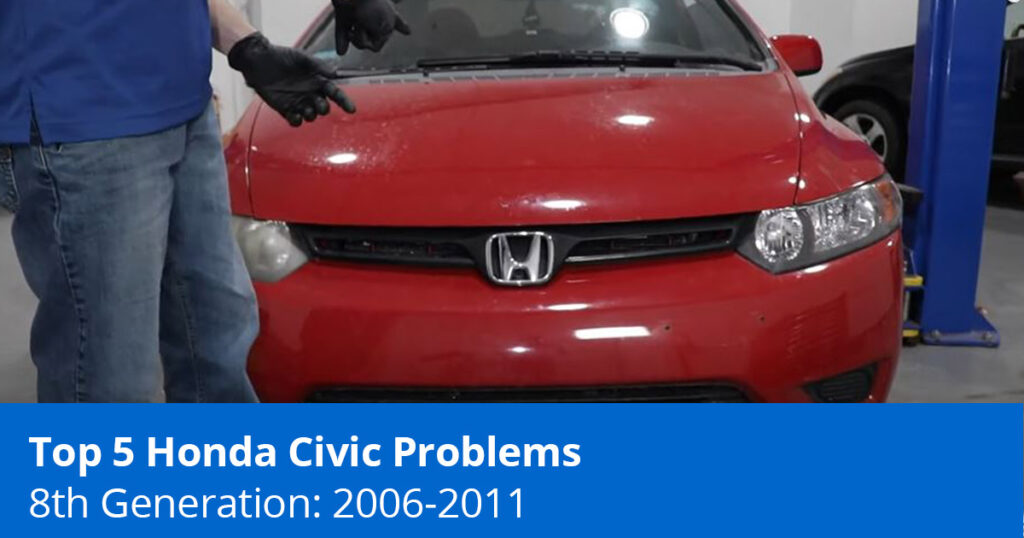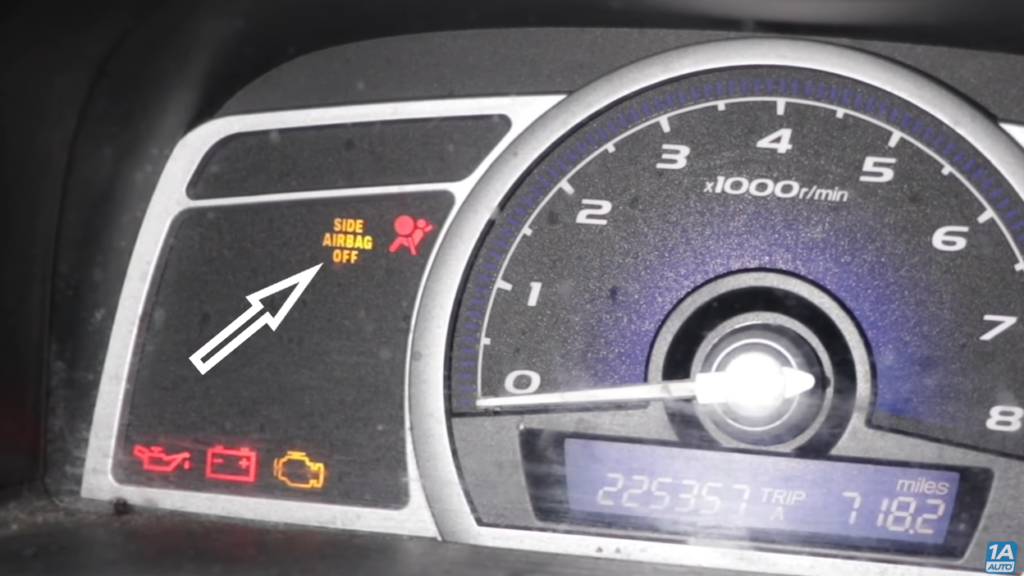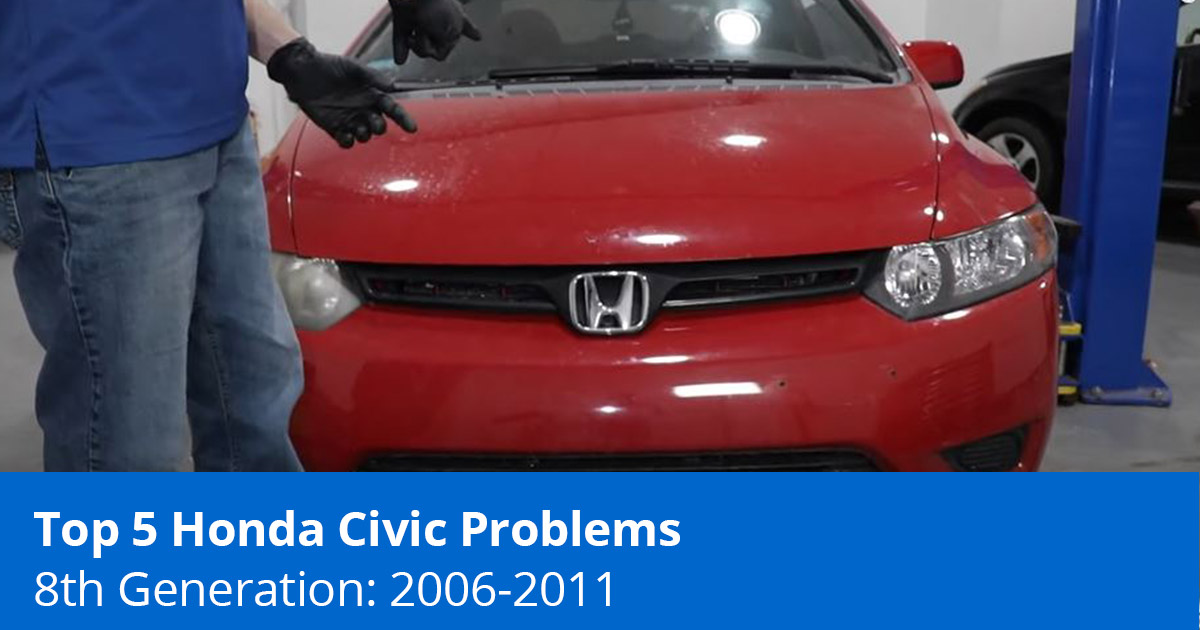
If you own an 8th gen Honda Civic (2006 – 2001), you may have come across a couple of problems that are unique to your car. Here are the top 5 Honda Civic issues that we have seen at 1A Auto in the 8th generation model. If you’re looking to buy one, this guide will help you know what to expect.

Resolving 8th Gen Honda Civic Problems (2006 to 2011)
1. Occupant Airbag Sensor

Symptoms of Occupant Airbag Sensor Failure
The most common symptom that you’ll notice when the airbag sensor goes bad is seeing the airbag light pop up on the dash. Unless you got involved in an accident, there’s really no other way to know when you’re having this issue.
Causes of Occupant Airbag Sensor Failure
The passenger side occupant airbag sensor ensures that the airbag is always ready to deploy. This only happens if the person seated weighs more than 50 pounds. If the person weighs less than that, the airbag is deactivated to prevent it from deploying. This ensures that it does not harm a child. Sometimes the airbag sensor can fail on the 2006 to 2011 Honda Civic.
How to Fix Occupant Airbag Sensor Failure
One of the best solutions for the problem would be to disconnect the negative battery terminal and leave it like that for about 30 minutes. Secondly, check to see if the two yellow connectors found underneath the passenger seat are well connected. You can squeeze them to see if they’ll click into place and check whether the light on the dash goes away.
It’s also very common for sensors to go bad. Honda has a recall out for the occupant airbag sensor. The next best solution would be to head over to Honda and have them go through the recall process.
2. Motor Mount Issues
Symptoms of Motor Mount Failure
Unfortunately, the bushing tends to wear and tear due to the continuous vibration coming from the engine. Symptoms here include a loud clumping and thumping noise that seems as if your engine is hitting up against your firewall. You may also see minor or major stress cracks on the mount’s rubber bushing and separation in severe cases.
Causes of Motor Mount Problems on the 8th Gen Honda Civic
Motor mounts are parts that hold the engine to the car’s body. They comprise two metal pieces–one connected to the engine and the other to the body. They have a rubber bushing in between to help absorb vibrations from the engine whenever you step on the gas.
How to Fix Motor Mount Failure
If you suspect your motor mounts are weak, grab a second person and have them do a brake stand (i.e. holding the brake and then the gas) in Drive while you watch the engine from one of the sides of the vehicle. Ask them to hold the brake and hit the gas. You want to see if the engine will rock around more than it’s supposed to.
If you don’t see any abnormal movements, ask the other person to do the brake stand in Reverse. Remember to stand at a safe distance from the car and away from the front or rear. You’ll need to replace all the engine mounts if you notice that there’s a lot of engine movement.
3. Window Switch Failure
Symptoms of Window Switch Failure
Electrical circuits don’t work well with moisture or water. As such, one of the symptoms that you might notice is a window that fails to go up or down when you operate the switch. The switch may also start to work after a couple of tries and stop again.
Causes of Window Switch Problems on the 2006 to 2011 Honda Civic
On the 8th generation Honda Civic, you’ll have window switches on the driver and passenger doors. The switches on the passenger door are notorious for going bad. This happens when moisture or snow gets through the window and penetrates into the switch’s circuit board.
How to Fix Window Switch Failure
The first step to fixing the problem is to take the switch apart and inspect it. You want to check if there’s corrosion, moisture, or debris that could have made its way in there. You can go further and test for power and ground and ensure those go where they are supposed to. If you have power getting to the switch but none leaving, you’ll need to replace the switch. Remember to also check the fuses for damage.
4. Front Control Arm Bushings
Symptoms of Front Control Arm Bushings
With time, the control arm bushings wear out due to exposure to oil and external elements. Some of the common symptoms you’ll notice include a clunking sound when accelerating, when going over bumps, or when coming to an abrupt stop. This happens when the rubber bushing fails to hold everything together while the control arm tries to shift.

The failure may also cause the car to feel a bit squirrely every time you hit a small bump. This is because the bushing creates some wiggle room for the control arm to do whatever it wants. If you were to look at your tires, you’d also notice that one side wears out more than the other. This is caused by an alignment issue that occurs as a result of a bad front control arm bushing.
Causes of Front Control Arm Bushings
The front control arms are parts that connect the vehicle’s sub-frame to the ball joint and knuckle attached to the wheel. They also feature rubber bushings for vibration dampening and noise reduction. They help with the control arm’s ability to pivot.
You can test the bushings by putting a pry bar in between the sub-frame and the control arm itself. You want to give it an upward push to see how much the arm moves. It’s also good to check for cracks and separations along the rubber.
The driver’s side will have two bushings and so will the passenger’s side. Remember to check them all. You’ll need to replace them if they are badly off. It’s also advisable to get a four-wheel alignment afterward.
5. Wiper Blade Motor Failure
Symptoms of Wiper Blade Motor Failure
You may notice that your wiper blades do not go all the way down when you turn them off. In serious cases, they may fail to operate. This is caused by a damaged wiper motor or something else that went bad in the wiper system.
Causes of Wiper Blade Motor Problems on the 8th Gen Honda Civic
The wiper blade motor is an electronic part of the wiper system that activates the regulator every time you operate the wiper switch. The regulator in turn moves the wiper arms to help clear your windshield of any water or debris. Since the motor is an electronic component, it’s bound to go bad over time. The problem could be permanent or intermittent.
This happens a lot when car owners try to clear heavy snow off their windshields using the wipers. It puts a lot of pressure on the arms and wiper motor.
How to Fix Wiper Motor Failure
The first step to fixing the problem is to first identify if the issue is permanent or intermittent.
The next is to check for blown fuses, bad wiring and confirm if you have power leading to the motor. If you have power getting to the motor but none leaving, you’ll need to replace it with a new one.
8th Generation Honda Civic Model Years
Related Content
- What are the Symptoms of Bad Motor Mounts?
- Why Is My Power Window Not Working?
- Front End Clunking Noise While Driving?
- Windshield Wipers Not Working? [Diagnose & Fix]
Shop 8th Gen Honda Civic Parts

